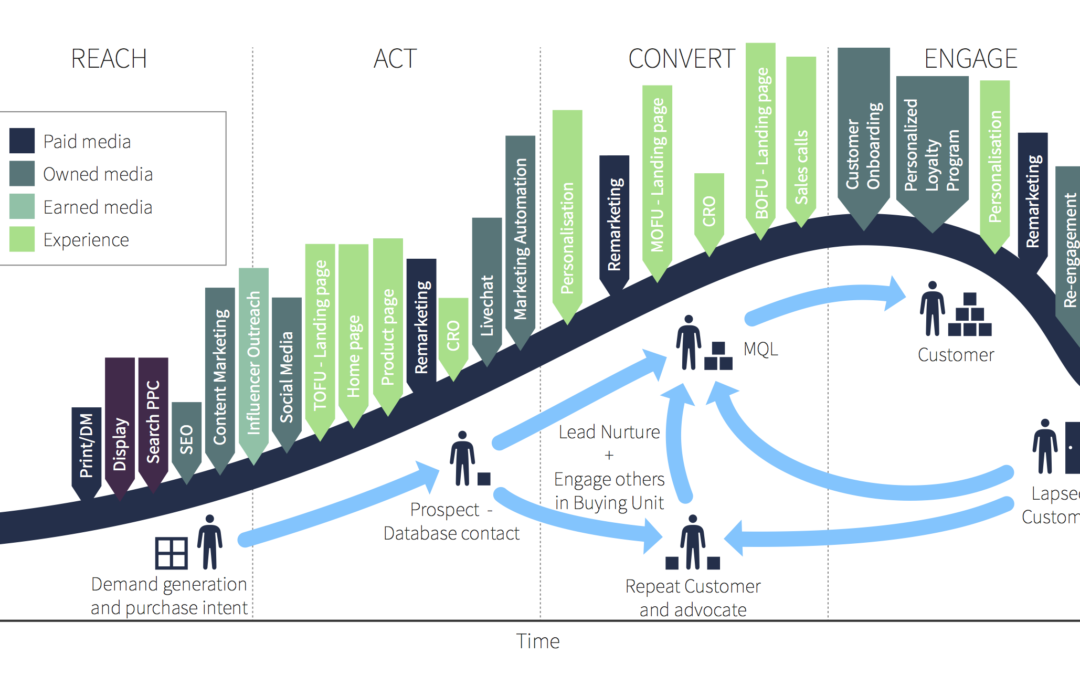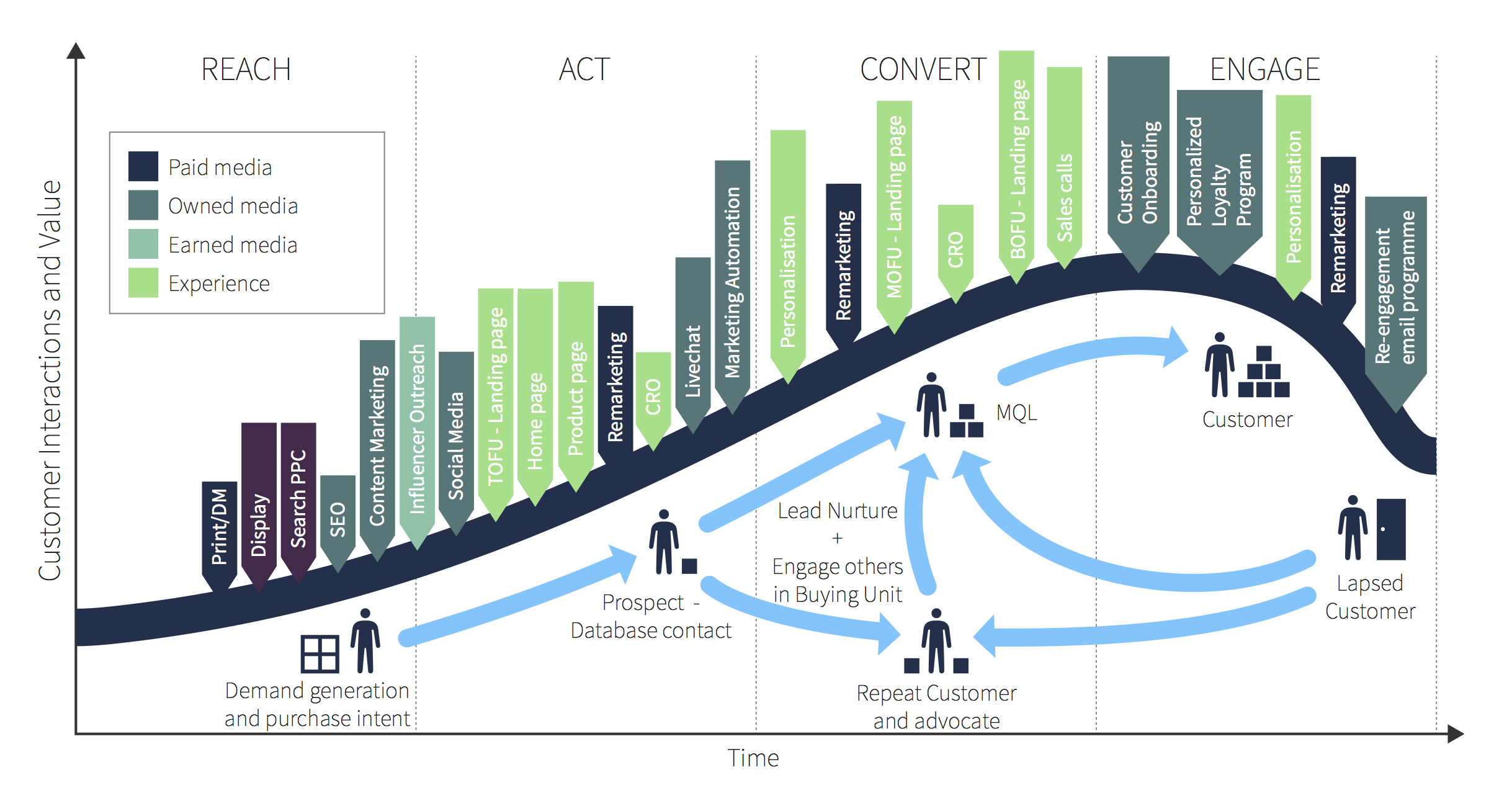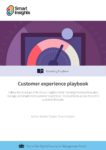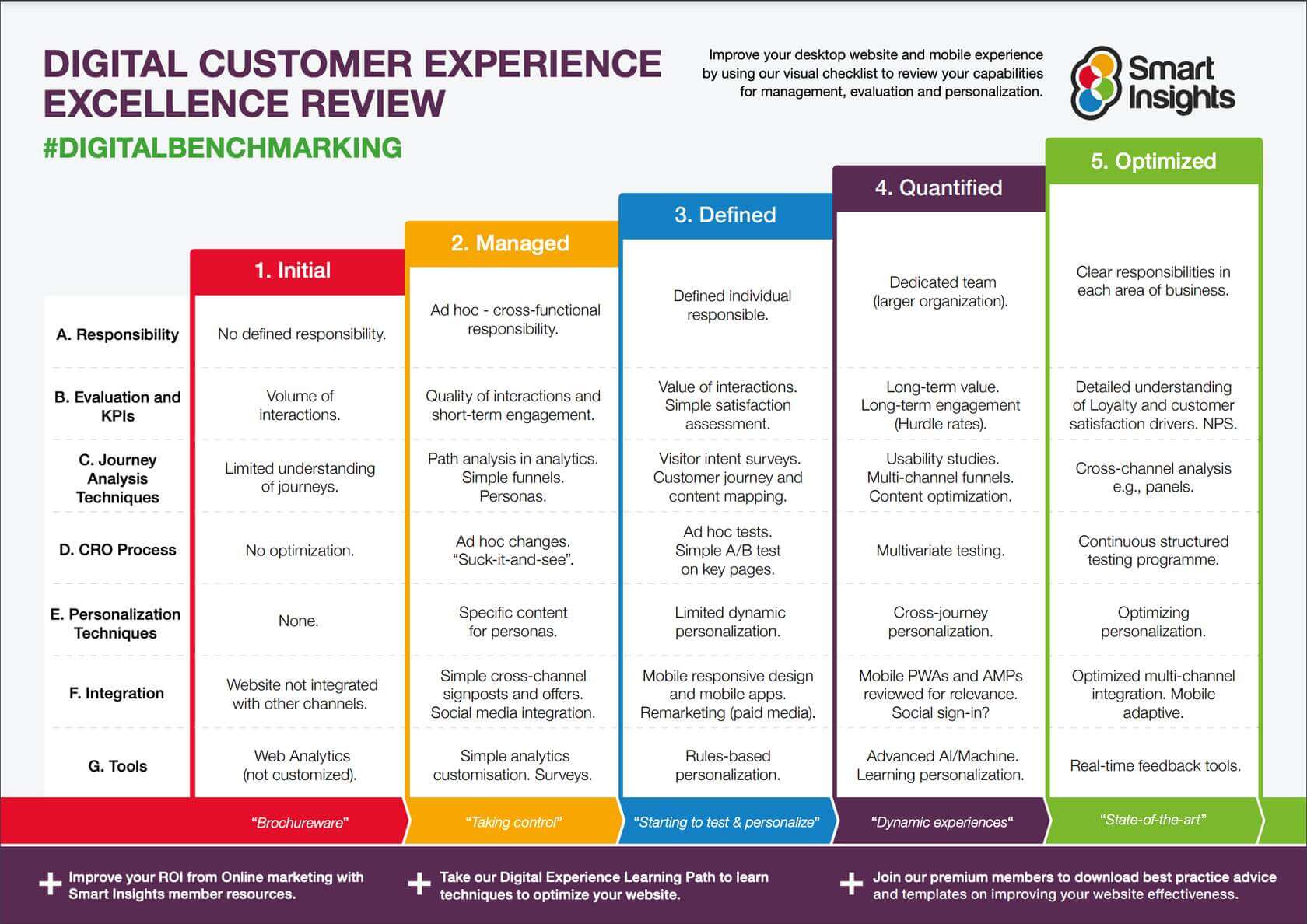Discover how a customer experience strategy that enhances digital experiences across all touchpoints can help build brand loyalty and improve ROI
In today’s fast-paced digital world, providing a seamless customer experience strategy is no longer a luxury but a necessity. As consumers have more options than ever on where, when, and how to interact with brands, ensuring a consistent and positive digital experience can significantly impact your business’s growth and competitiveness.
It’s easy to forget just how many touchpoints your business may have. The Smart Insights customer lifecycle visual highlights just some of the many paid, owned, and earned media omnichannel options available today to communicate with prospects and customers. There’s a lot!
The diverse array of channels highlights the amount of avenues we need to effectively manage to create effective customer experience, no matter where or how a customer interacts with us.
However, due to the speed at which our industry moves and the amount of changes we have to regularly adapt to, it can be easy to neglect implementing a customer experience strategy. In doing so, you may be losing potential customers to competitors at various stages of the lifecycle, without even knowing.
What do we mean by customer experience?
Customer experience refers to the cumulative impact of all interactions a customer has with a brand throughout their entire journey. This includes every touchpoint, from initial awareness and engagement to post-purchase support and advocacy. A positive customer experience is characterized by ease of use, personalized interactions, and consistent satisfaction across all channels.
Integrating customer experience into your marketing strategy is essential because it not only influences customer retention and loyalty but also enhances brand reputation and drives revenue growth. By prioritizing customer experience strategy, businesses can differentiate themselves in a crowded marketplace and create lasting relationships with their customers.
Why does customer experience matter?
Customers form opinions about your brand through various digital touchpoints, whether it’s via social media, your website, or email campaigns. We need to go beyond customer actions here and really consider their emotions and feelings to truly understand sentiment. As TechTarget summarizes:
“Managing customer experience isn’t just about how people perceive their experience with a brand or the actions a company takes, but how customers feel when engaging with a brand.”
If these interactions are not optimized, you risk losing customers to competitors who offer a more engaging and satisfying experience. A well-structured customer experience strategy can be the decisive factor between thriving in your market or lagging behind competitors.
Top Tip: Think ‘consistency’. You want your customers to feel comfortable that they know what to expect when interacting with you at any stage of their journey, at any touchpoint. This is why brand messaging and experience needs to be consistent across all channels, to help build brand trust and reliability.
What does good customer experience look like?
This will vary depending on your business, industry and product/service. However, there are some key fundamentals that apply to any business, which Hojar has succinctly summarized.
“In short, good customer experience can be achieved when you:
- Make listening to customers a top priority across the business
- Use customer feedback to develop an in-depth understanding of your customers
- Implement a system to help you regularly collect, analyze, and act on feedback
- Reduce friction and solve your customers’ specific problems and unique challenges”
Benchmarking your customer experience
When diving into any marketing optimization, we first need to consider – where are we now? And what are we basing that on?
Customer experience of all brand interactions is often based on Voice of Customer (VoC) tools, like customer ratings and surveys of satisfaction that are benchmarked, but often these don’t drill down into satisfaction with online channels which account for a high proportion of interactions. There are also behavioural measures of satisfaction with experience that with digital you can assess directly and aim to improve.
Top Tip: A great way to better understand your customers’ pyschographic motivators, is to work on your personas and customer journey maps. For more advice on this, read our How to create an actionable customer journey map using RACE blog.
Our Digital Customer Experience review (shown below) enables you to review your capabilities for managing digital experiences too. Where does your business currently sit?
Looking at the benchmarking visual, it’s likely that you can already see areas you can improve to take you to the ‘Optimized’ stage consistently across channels. Now you have identified where you need to improve, it’s important to build these key activities into your customer experience strategy.
Key elements of a robust customer experience strategy using RACE
To effectively manage and improve customer experience, we can split up areas to optimize effectively using Smart Insights RACE Planning Framework. Our newly launched customer experience playbook is built using RACE, providing a detailed roadmap to enhance your digital customer interactions. RACE can support you in delivering an exceptional customer experience strategy by splitting out activities across the full customer lifecycle:
- Plan: Set clear objectives and measurement criteria. Define the scope of customer experience, focusing on online interactions which often form a high proportion of customer engagements.
- Reach: Increase your brand’s visibility and demand through effective use of digital media. This involves improving your SEO, integrating social media strategies, and ensuring your content reaches the right audience.
- Act: Encourage digital interactions that lead to increased subscribers and leads. By enhancing your website’s customer journeys and providing relevant, engaging content, you can significantly boost user engagement.
- Convert: Turn your prospects into customers by optimizing conversion rates through an omnichannel approach. This includes both online and offline tactics to ensure a smooth transition from lead to customer.
- Engage: Build long-term customer loyalty and advocacy by maintaining consistent communication through email marketing, social media, and other digital channels. Engaging your customers beyond the initial purchase is key to fostering lasting relationships.
Benefits of focusing on customer experience
Although it may never feel ‘top of the list’, optimizing your digital customer experience can really help support your overall business goals by creating:
- Increased Customer Loyalty: Satisfied customers are more likely to return and recommend your brand to others.
- Improved Brand Reputation: Positive experiences lead to positive reviews and word-of-mouth marketing
- Higher Conversion Rates: Optimized customer journeys reduce friction and increase the likelihood of conversions.
- Enhanced Customer Insights: Understanding customer behaviour helps refine marketing strategies and product offerings.
Continuous improvement
Improving your digital customer experience is a continuous process that requires careful planning, execution, and evaluation. At Smart Insights, we have developed a comprehensive playbook to help you navigate this journey step by step.
To dive deeper and start optimizing your digital customer experience, download our customer experience playbook. This resource provides detailed strategies and actionable insights to help you create and deliver a strong customer experience strategy across all touchpoints, and links to useful Smart Insights resources and templates to help you at each stage.




